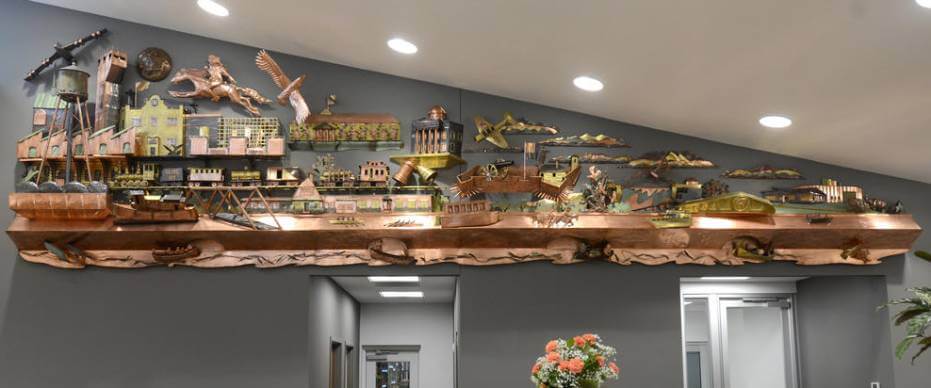By Nicole A. Hawley
For an idea Jon Brodock “didn’t know would work,” officials and visitors alike are hailing a copper mural depicting the industrial history of Rome at his business “historically significant” for the community.
Brodock retired about 11/2 years ago and decided he would explore his own artistic endeavors. His journey led him to make a copper sculpture for his business — Kris-Tech Wire — for the company’s new building at 80 Otis St. As designs were being drawn for the new building, Brodock decided to leave some wall space for his creation.
Brodock would approach copper sculptor Jude Ferencz, of Cazenovia, with a sketch of his idea. Today he calls that “idea” the Copper City Mural. Ferencz’s sculptures and artwork can be found at www.coppermetaljude.com.
“I approached Jude and asked if he’d do a copper sculpture with me, and here he never worked with anybody,” Brodock said.
The pair used Brodock’s sketch and went around taking photos of different landmarks within the city, using them as reference for the sculpture.
Some highlights of the Copper City Mural include:
De-O-Wain-Sta: The Carrying Place, fur trappers and Native Americans
The Oneida people, who form part of the Iroquois Confederacy, frequented the land to become Rome. Known as the U.S.’s first ally, the Oneidas fought with the colonists during the American Revolution. The Oneida Carry was a portage for boats and cargo located on the main 18th century trade route between the Atlantic seaboard of North America and interior of the continent.
Fort Stanwix
National Monument
The fort was the site of a prolonged siege attempt in 1777 by British, German, Loyalist, Canadian and American Indian troops and warriors. The failed siege foiled an effort by the British to take the northern colonies. Current reconstruction of the fort was completed in 1978, and it is managed by the National Park Service.
Paul Revere on a Horse
Revere was a silversmith by trade. In 1800, he became the first American to successfully roll copper into sheets for use as sheathing on “Old Ironsides” and other naval vessels. He is best known for his “midnight ride” on horseback as he alerted the colonial militia that British forces were approaching before the battles of Lexington and Concord.
Spargo Wire — start of the wire industry in the U.S.
In 1902, Jim Spargo organized the James A. Spargo Wire Company on East Dominick Street.
Railroad Coming to Rome
Railroad had first come to Rome in the summer of 1839 during the completion of the Syracuse and Utica Railroad. The line had been built on stilts across the muck flats south of the village, generally following the course of the Erie Canal. Building of railroads was directly responsible for a major portion of industrial development in Rome.
St. John’s Church
In 1910, the first church designed for Rome’s Italian population was established at 311 E. Dominick St. It took the name of St. John the Baptist and in 1914, a new church was completed on River Street, which was active for almost 40 years. The present structure sits at the corner of East Dominick and River streets.
The Bald Eagle
The bald eagle is both the national bird and national animal of the U.S. and appears on the U.S. seal. Once considered an endangered species, the ban on the use of DDT pesticides has allowed eagles to return to the area and are often seen at neighboring Lake Delta.
The Delta Lake dam, Rome Cable tower, B-52 Bomber, Francis Bellamy’s American flags, the Erie Canal, and cows depicting Jesse Williams the cheese maker, who made Rome the leading cheese market in the world by 1863, are other landmark tributes to Rome found on the mural. Brodock also included three pieces to represent Kris-Tech Wire — the old building on Seneca Street, the new one on Otis Street, and an electric speed train car to represent the unexplored future of the leading wire manufacturing company.
It took about six months for Brodock and Ferencz to construct each piece of the mural in his barn. By the end, Brodock learned enough about soldering and copper metal work that he was able to sculpt the eagle mainly on his own.
Four different types or colors of copper were used — about 1,000 pounds worth. The green that depicts ivy and grass came from the aged copper roof that once lay on top of the old Kris-Tech building on Seneca Street.
“We would go in 100 different directions each day, which made the project really challenging,” Brodock said. “It was an idea we didn’t know would work. We crossed some bridges, and the stars aligned, and it just worked.”
Brodock has partnered with Rome Historical Society to create a booklet that tells the historical significance of each piece found in the mural. Booklets will be available at Kris-Tech and the historical society on Church Street.
Brodock hopes to keep the lobby of Kris-Tech “casually” open to the public so that anyone may view the Copper City Mural, as long as visitors respect it as a work space.
“This is an historically significant sculpture for the community,” and will be for years to come, said Patrick Reynolds, educator at Rome Historical Society. “Each building and each element has an individual story. Hopefully the sculpture will spark people’s interest in history as well.”

http://www.romehistoricalsociety.org